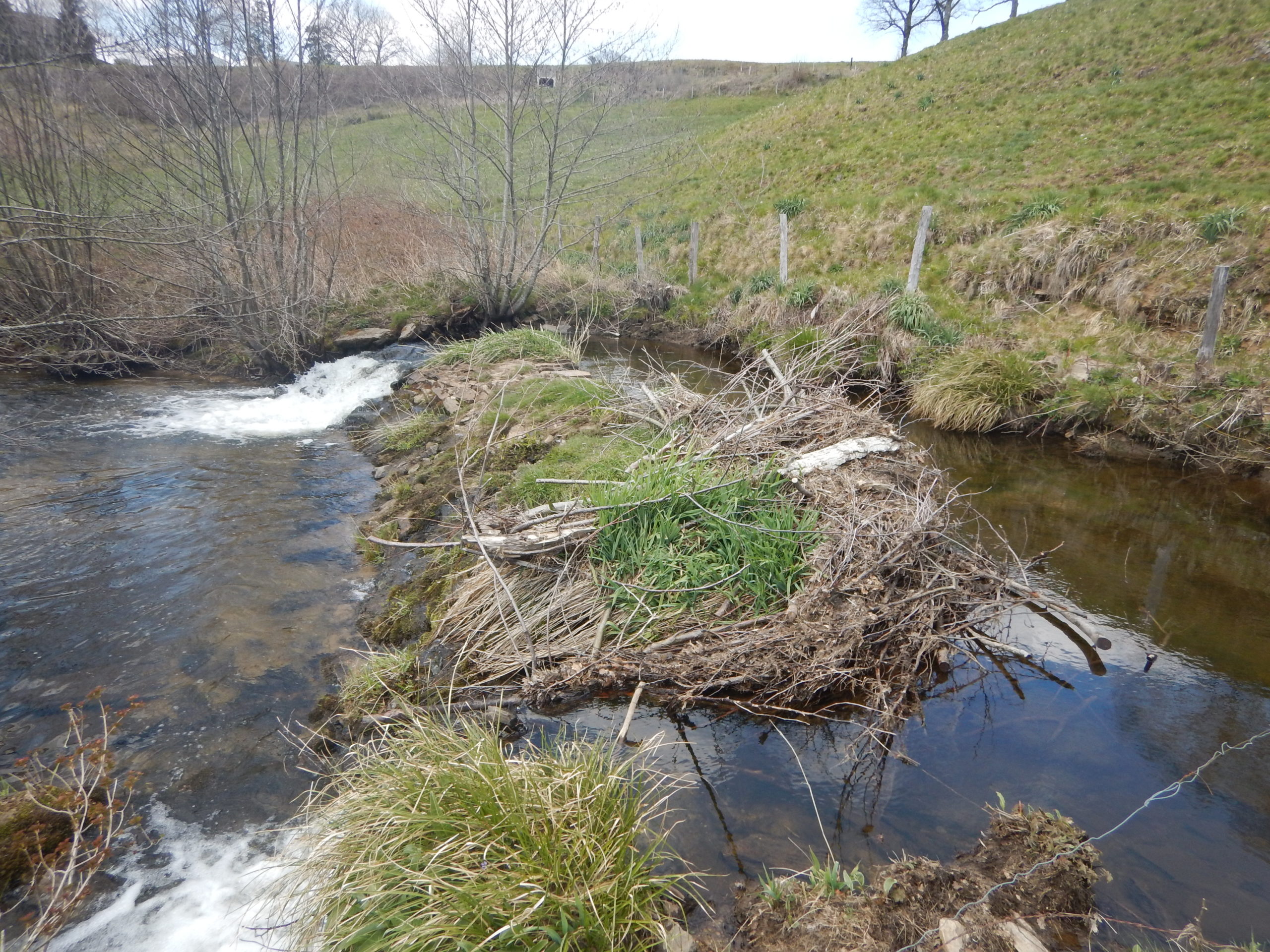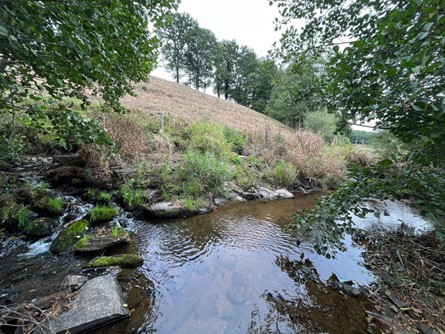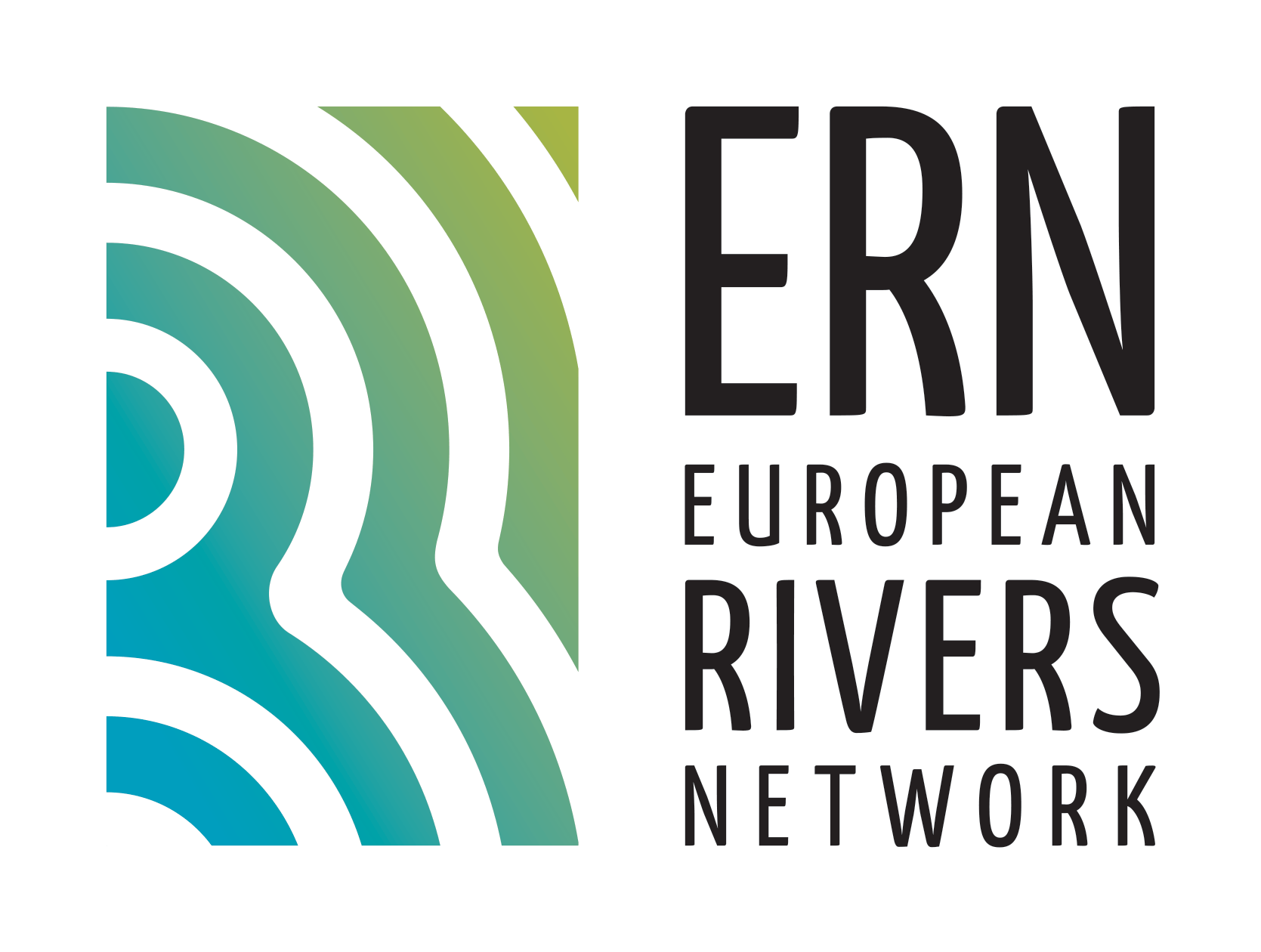REMOVAL OF A WEIR ON A WATERCOURSE WITH A PEARL MUSSEL ISSUE
Removal of the Pont de Rhodes weir on the Ressegue (Cère downstream watershed), Cantal, France, 2024
THE PROJECT
The Pont de Rhodes weir is located on the Ressègue, a tributary of the Escalmels stream, which in turn flows into the Cère. This site is part of the Natura 2000 FR8302033 Special Area of Conservation: “Affluents de la Cère en Chataigneraie” (Tributaries of the Cère in Chataigneraie), notable for its population of pearl mussels and recent evidence of their reproduction. The freshwater pearl mussel is listed on the IUCN Red List (EN- Endangered for France). Other species of heritage interest are present, such as the European otter, which is near threatened at the European level, and the brown trout, a heritage species and host in the pearl mussel’s reproductive cycle.
The Ressègue is classified as a first-category fishing river and is listed as a Category 1 river along its entire course and as a Category 2 river downstream from the Cros bridge. List 1 characterizes watercourses in very good ecological condition or identified by master plans as playing a role as biological reservoirs. List 2 aims to restore ecological continuity and requires the restoration of fish movement and the proper transport of sediments. The project area is listed on List 1 and 2.
This abandoned weir caused a break in river continuity. It limits the movement and reproduction of local species that are essential to the development of the pearl mussel population. Sediment continuity is also disrupted, leading to significant silting upstream, the quality of the substrate is essential for the mussels to settle and for the creation of spawning grounds for trout. As the watercourse is bordered by agricultural plots, there are no particular constraints to removing the structure.
The restoration work has reconnected 13 km, or 96% of the Ressegue watercourse and 26 km of watercourses throughout the watershed. The grain size, water quality, habitats favorable to brown trout and their host mussels, and the distribution area of these species will be improved, as will the hydromorphological functioning of the river.
CONTEXT AND OPPORTUNITY
The Ressègue is classified as List 2 under Article L214-17 of the Environmental Code, which requires owners to comply with regulations regarding ecological continuity. Given its importance for the reproduction and habitat of the freshwater pearl mussel (Margaritifera margaritifera), the removal of structures on this watercourse has been deemed a priority by the expert unit of the National Action Plan for Freshwater Pearl Mussel in Auvergne-Rhône-Alpes. This action would bring significant ecological benefits to the river and would enable the connection of two populations of freshwater pearl mussels. With the agreement of the owners, the project was launched in this direction by the Syndicat Mixte de la Dordogne Moyenne et de la Cère Aval (SMDMCA), which is responsible for managing aquatic environments and flood prevention in the Escalmels watershed and its tributaries, including the Ressègue.
Thanks to the support of the European Rivers Network, the Open Rivers Programme provided financial backing to enable the owners to pursue this solution and to ensure compliance with French legislation. A grant for preliminary studies and works was awarded in 2022 and 2023. The works carried out by the SMDMCA were completed in September 2024.
The Open Rivers Programme was an opportunity for the owners and the SMDMCA, as it allows for the financing of studies and works for the removal of structures under 2 meters high through philanthropic funds. This action is part of the future multi-year management plan led by the SMDMCA in the Cère aval watershed, which aims to improve the quality of the environment through the restoration of wetlands, the restoration of ecological and sediment continuity, bank protection, riparian woodland management, biological monitoring, etc.
PROJECT GOALS
The project led by the European Rivers Network launched a comprehensive study of the Pont de Rhodes dam, focusing on its removal and the reinforcement of weakened banks using vegetation-based engineering techniques. The project team successfully addressed the challenges and integrated valuable feedback from technical partners. The project is compliant with the European Water Framework Directive and aligns with master plans, demonstrating a commitment to environmental protection.
- Reduce watercourse fragmentation on the Ressegue to allow local migrations (trout):
The removal of the obstacle will open up 13 km of river from downstream up to the sources, resulting in a completely free-flowing watercourse. When including the Ressegue’s tributaries, nearly 29 km of watercourses will be reconnected. - Restore hydromorphological functioning:
The Ressegue transports large quantities of fine sediments, which are blocked and accumulate at the obstacle. Sediment transport is therefore partially interrupted. This results in riverbed incision at the base of the structure, various erosion problems, and an unsuitable grain size of the riverbed. The obstacle causes hydromorphological dysfunction in the Ressegue. Up to 500 meters upstream of the structure are affected by clogging. - Improve water quality:
The accumulation of materials at the obstacle leads to a homogenization of grain size (with a significant presence of sand and silt) and a uniformity of flow velocities. These effects result in a degradation of the environment: less oxygenated water, increased temperature, loss of habitats, clogging of the environment, and potential loss of larval habitats. - Restore habitats for target species:
Current clogging reduces the area of suitable habitats for the freshwater pearl mussel. Individuals can be found in the rapids at the base of the structure, which are not clogged, but very few have been identified upstream of the structure. The removal of the structure would therefore reduce this clogging pressure and provide a larger area of suitable habitat for the mussels.

© Drone ki peut

©SMDMCA, view from the left bank

©SMDMCA, ©SMDMCA, view from the left bank

©SMDMCA, view from downstream of the structure

©Drone ki peut
AT A GLANCE
- Location : Communes in the Cantal department (15), France
- River : La Ressegue
- Length of watercourse reconnected : Total : 29 km – 13 km on the Ressegue up to the river’s sources – access to 5 tributaries for over 16km
- Target species : Brown trout (Salmo trutta), Freshwater pearl mussel (Margaritifera margaritifera), European otter (Lutra lutra)
- Habitats : Natura 2000 site: FR8302033 – Affluents of the Cère in Chataigneraie
- Partners : Project owner: SMDMCA www.smdmca.fr, 100% funded by the Open Rivers Programme

 ERN France
ERN France ERN is the official WWF Freshwater Partner in France and cooperates with WWF Switzerland, Austria, Netherlands and others
ERN is the official WWF Freshwater Partner in France and cooperates with WWF Switzerland, Austria, Netherlands and others